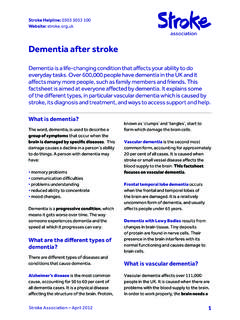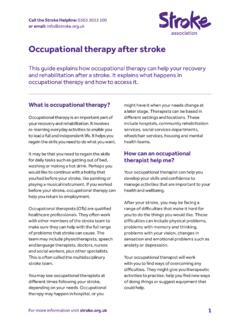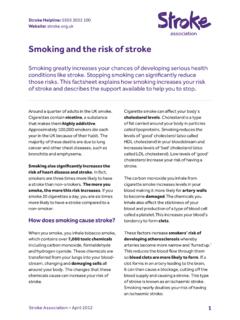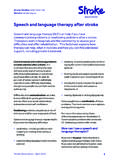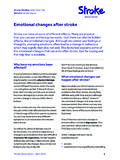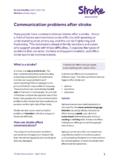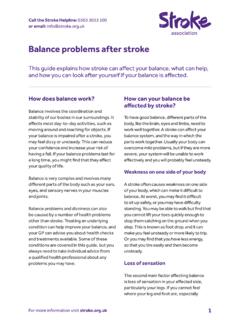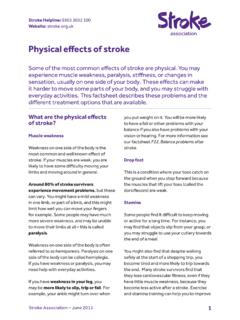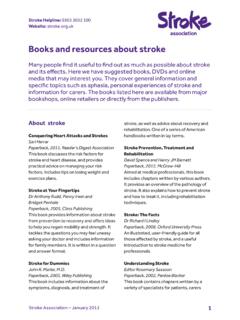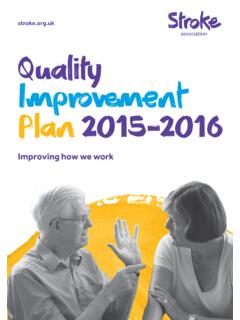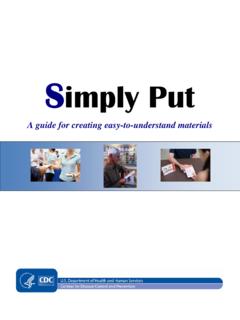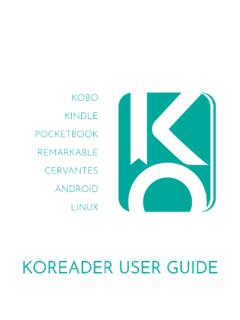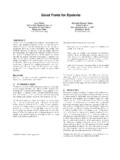Transcription of stroke.org.uk Accessible Information Guidelines
1 Accessible Information Guidelines Making Information Accessible for people with aphasia We believe in life after stroke. That's why we support stroke survivors to make the best recovery they can. It's why we campaign for better stroke care. And it's why we fund research into new treatments and ways of preventing stroke. We're here for you. If you'd like to know more please get in touch. Stroke Helpline: 0303 3033 100. Website: Email: Textphone: 18001 0303 3033 100. Stroke Association, July 2012. ISBN 978-0-901548-66-5. All rights reserved. No part of this publication may be reproduced or transmitted, in any form or by any means, electronic, photocopying or otherwise without prior permission of the publishers.
2 NHS workers and teachers may make photocopies for education purposes only, provided that no charge or profit is made for any course or event for which they are used. Published by the Stroke Association Stroke Association House 240 City Road London EC1V 2PR. Stroke Association is a Company Limited by Guarantee, registered in England and Wales (No 61274). Registered office: Stroke Association House, 240 City Road, London EC1V 2PR. Registered as a Charity in England and Wales (No 211015). and in Scotland (SC037789). Also registered in Northern Ireland (XT33805) Isle of Man (No 945) and Jersey (NPO 369).
3 2 Stroke Association Contents Authors and acknowledgements 4. Introduction 5. The Five Steps 9. Step 1: A short message 10. Step 2: Clear sentences 11. Step 3: Easy words 14. Step 4: Good layout 15. Step 5: Make a set 21. Checklist 23. Word-processing advice 24. Further Reading 28. Notes 30. Accessible Information Guidelines 3. Authors Ruth Herbert, Department of Human Communication Sciences, University of Sheffield Caroline Haw, Community Intermediate Care Service, Sheffield Teaching Hospitals NHS Foundation Trust Catherine Brown, English Language Teaching Centre, University of Sheffield Emma Gregory, Department of Human Communication Sciences, University of Sheffield Shelagh Brumfitt, Department of Human Communication Sciences, University of Sheffield Acknowledgements We thank all the people with aphasia and their families who contributed to the development of these Guidelines .
4 We are extremely grateful for the time, thought and effort that they put into helping us with this work. Thank you. We are very grateful to Jon Dale of Transmit Creative for working with us to design the card sets. Thanks are also due to members of staff at the Stroke Association. Maggie Warburton initiated the project, enabling us to work on the Guidelines and on a related project. Aileen Donald has supported the work from an early stage and continues to provide us with help and guidance. Several members of staff based in Sheffield facilitated our recruitment of people to the project.
5 Finally thanks are also due to the speech and language therapists, and the Stroke Association employees who gave us their opinions of the Guidelines . Thanks to all of you. 4 Stroke Association Introduction The Stroke Association provided the funding for the development of these Guidelines . They are designed for use by people working with people with aphasia. They aim to help people produce written materials, in order to make them more Accessible to people with aphasia. We have written these Guidelines in an Accessible form in order to demonstrate as far as is possible the kind of written style we are aiming for.
6 What is aphasia? Aphasia can happen after a stroke Aphasia affects language Aphasia can affect understanding and talking Aphasia can affect reading and writing Aphasia is different for different people The need for Guidelines People with aphasia need Information . They need Information about the effects of stroke and about aphasia. They need Information about life after stroke. Aphasia can make it difficult to make sense of new Information . New Information is often not Accessible to people with aphasia. Making Information Accessible is a challenge. Health-workers and others need Guidelines to help them make Information Accessible .
7 Accessible Information Guidelines 5. Development of these Guidelines Our research project studied what helps people with aphasia understand Information . We looked at the literature on aphasia and Accessible Information . The references we looked at are on page 28. We consulted people with aphasia in focus groups. They told us what helps them understand Information . These Guidelines are a summary of the main points we discussed. Who are these Guidelines for? If you work with or know someone with aphasia, these Guidelines are for you. The Guidelines can help to make everyday Information Accessible .
8 The Guidelines can help to make more complicated Information Accessible . They are intended to help people with aphasia live their lives, through better Information . 6 Stroke Association What are these Guidelines for? These Guidelines can be used to make any Information Accessible . Some examples are: Information about services Communication resources Explanations to people about their condition Letters to people with aphasia Setting goals with people with aphasia Medical Information Ward notices Explanations to people about their care Accessible Information Guidelines 7.
9 How to use these Guidelines Identify what you want to communicate Work from an existing document or start from scratch Use these Guidelines to make your Information more Accessible The Guidelines give you advice on the types of words and sentences to use The Guidelines give you advice about pictures and layout There is advice about the amount of Information to include The Guidelines assume you are using Microsoft Word on a computer You can also use the principles to produce Information by hand 8 Stroke Association The Five Steps There are Five Steps to follow Step 1: A short message Step 2: Clear sentences Step 3: Easy words Step 4: Good layout Step 5: Make a set There is a checklist on page 23 to help you.
10 Use the advice on using Microsoft Word on page 24 to produce materials. There are examples to help you, in shaded boxes. Blue text shows the issue we are talking about. Our amended versions follow in bold. Accessible Information Guidelines 9. Step 1: A short message Make sure you have a clear message Write your Information down Cut out anything that is not needed Are there several messages? Separate the messages out Make a list of your messages Put them in a logical order Stroke makes it difficult to move one side of your body, so you may find walking and getting about harder.
